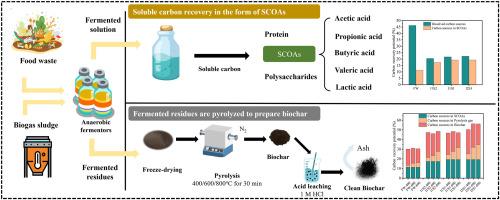Anaerobic fermentation integrated with pyrolysis for carbon resource recovery from food waste and biogas sludge: Effects of inoculation ratio and pyrolysis temperature
IF 8.4
2区 环境科学与生态学
Q1 ENVIRONMENTAL SCIENCES
引用次数: 0
Abstract
In view of the food waste (FW) as well as its digestate are both the organic sources of municipal solid waste, this study explored the anaerobic fermentation (AF) and following pyrolysis carbonization to co-disposal the two wastes for carbon resource recovery, including short chain organic acid (SCOAs), pyrolysis gas and biochar. Results indicated that both the rate and yield of SCOAs production both increase with the rising ratio of biogas sludge (BS) to FW, enhancing the soluble carbon recovery. The highest SCOAs production of 474.33 mg/g-VS was achieved at the ratio of 2:1 in 72 h. To further utilize the carbon source, the solids from the fermented residue (FR) was pyrolyzed at 400, 600 and 800 °C, respectively. Findings showed that the carbon content in biochar decreases with the increasing pyrolysis temperature, while the carbon in pyrolysis gas exhibits the opposite trend. Integrating the AF and pyrolysis contributed to a carbon recovery about 56.39% when the FW and BS were co-fermented at a 2:1 ratio, followed by its FR was pyrolyzed at 600 °C. Additionally, the biochar prepared under these conditions displayed a specific surface area (SSA) of 313.10 m2/g, along with abundant pore structures and functional groups, indicating its potential applications as pollutant adsorbents and soil amendments. This research offers a new perspective on efficiently recovering high-value carbon sources through the co-treatment of FW and its digestate via AF integrated with pyrolysis.

厌氧发酵结合热解法回收餐厨垃圾和沼气污泥碳资源:接种比和热解温度的影响
鉴于食物垃圾(FW)及其消化液都是城市生活垃圾的有机来源,本研究探索厌氧发酵(AF)和热解炭化(热解后炭化)共同处理两种垃圾进行碳资源回收,包括短链有机酸(SCOAs)、热解气和生物炭。结果表明,随着污泥比的增加,SCOAs的生成速率和产率均增加,可溶碳回收率提高。以2:1的比例在72 h内获得了最高的SCOAs产量474.33 mg/g-VS。为了进一步利用碳源,发酵残渣(FR)的固体分别在400、600和800℃下进行热解。结果表明,随着热解温度的升高,生物炭中的碳含量呈下降趋势,而热解气体中的碳含量呈相反趋势。当FW与BS以2:1的比例共发酵时,将AF与热解结合,其碳回收率约为56.39%,其次是FR在600℃下进行热解。此外,在此条件下制备的生物炭的比表面积(SSA)为313.10 m2/g,具有丰富的孔结构和官能团,表明其作为污染物吸附剂和土壤改进剂具有潜在的应用前景。该研究为通过AF与热解相结合的方式对FW及其消化物进行共处理,高效回收高价值碳源提供了新的视角。
本文章由计算机程序翻译,如有差异,请以英文原文为准。
求助全文
约1分钟内获得全文
求助全文
来源期刊

Journal of Environmental Management
环境科学-环境科学
CiteScore
13.70
自引率
5.70%
发文量
2477
审稿时长
84 days
期刊介绍:
The Journal of Environmental Management is a journal for the publication of peer reviewed, original research for all aspects of management and the managed use of the environment, both natural and man-made.Critical review articles are also welcome; submission of these is strongly encouraged.
 求助内容:
求助内容: 应助结果提醒方式:
应助结果提醒方式:


